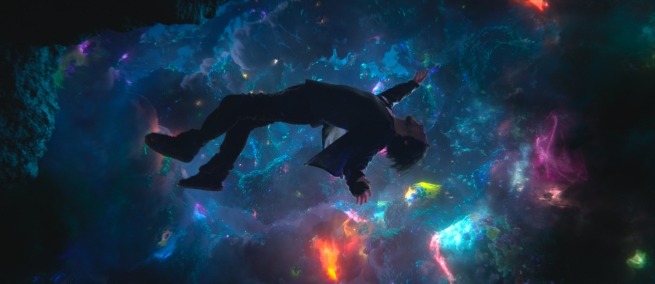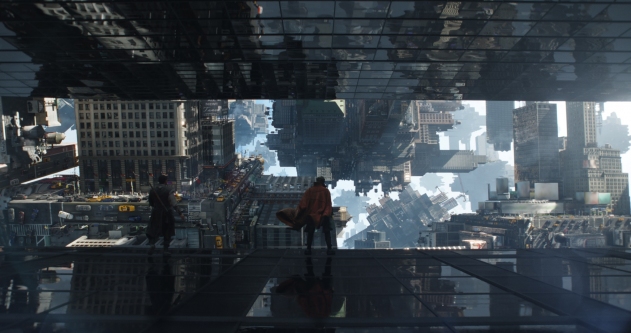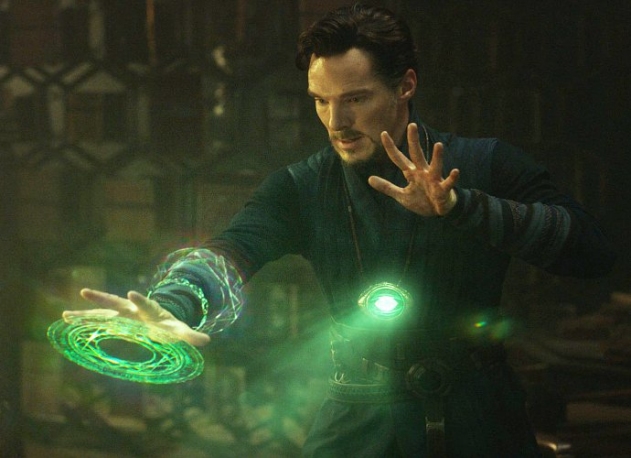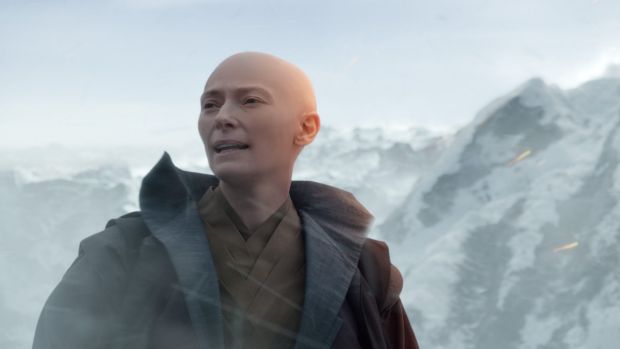
The latest Marvel Studios film DOCTOR STRANGE takes place in a world where multiple universes exist–called the multiverse. Benedict Cumberbatch plays a neurosurgeon who looses the use of his hands. He journeys to the Himalayas and becomes a disciple of the Ancient One (played by Tilda Swinton), who teaches him magic. These spells allow him to control time.
In physics, the multiverse is a theory of space-time. Astrophysicist Adam Frank consulted with DOCTOR STRANGE director Scott Derrickson on the physics in the film. In an NPR interview, Frank said that in physics the multiverse can be, “where each different universe has entirely different laws.” It could also mean, “that every time a quantum event happens, every time an atom radioactively decays, the universe splits into multiple parallel versions of itself. And that goes on and on and on.” In the film, Doctor Strange can open the doorway to an alternate universe, and to parallel universes in order to move through time.

In the Los Angeles Review of Books, Speculative Fiction Editor David M. Higgins writes about Doctor Strange’s ability to turn back time in relation to the 2016 political climate. The entire piece, “Doctor Strange and the Trump Presidency,” is republished with permission below.
I saw DOCTOR STRANGE the night after the presidential election, and it felt impossible not to notice that the film has a certain eerie prescience: this story, released just days before Donald Trump’s electoral victory, centers on the fantasy of having the power to turn back time just a few moments — to rewind the catastrophe, to freeze the disaster-in-progress, to hurl oneself into the struggle with an unrelenting refusal to allow the unthinkable to occur (even though it already has).
I’ll minimize spoilers as much as possible for those who haven’t seen the film. In short, Doctor Strange learns a spell at the midpoint of the story that enables him to manipulate time. We watch as he fast-forwards an apple into its own future — several bites vanish until only a core remains, and then the core begins to rot — and he then rewinds the apple’s decay until it is once again fresh and pristine. The aesthetics of this temporal magic are one of the film’s singular accomplishments. Strange literally twists time’s flow, like an audio or video editor scrubbing a digital media file. When digital editors “scrub” a media clip, they are able to move back and forth within sounds and images at variable speeds; Strange is able to scrub reality in exactly this way. The psychedelic magical effects in the movie as a whole center on the ability of sorcerers to edit, fold, and manipulate reality in ways that transcend the straightforward CGI magic (fireballs, etc.) that we’ve become familiar with from the visual imaginings of HARRY POTTER and LORD OF THE RINGS. The 1960s day-glow and lava-lamp aesthetic of Steve Ditko’s original renderings of the Sorcerer Supreme are updated for Christopher Nolan–era sensibilities, and viewers are invited to contemplate what it is like for a Marvel superhero to have the power to bend and twist reality into the kinds of sublime patterns that Nolan has previously offered in blockbuster FX films like INCEPTION and INTERSTELLAR.
At the film’s climax, Strange (like so many Stan Lee heroes) finally accepts that with great power comes great responsibility, yet he arrives at the final battle moments too late — the unimaginable has already happened, and the apocalypse is already unfolding. Undeterred by time’s arrow, Strange uses his temporal magic to reverse the events that have already taken place (this leads to a gorgeous climactic battle that occurs in a city in the surreal process of becoming undestroyed). In the end, moments before the ultimate catastrophe will occur, Strange exits our dimension to confront the film’s true villain, and he prevails through a relentless refusal to allow darkness to invade the Earth, even if this means that he must sacrifice himself an infinite number of times while suffering endless torment and devastation.

A friend and colleague, Paweł Frelik, once kindly admonished me to avoid getting caught up in the often-shallow narratives of blockbuster films; there are other more interesting things to look at, for example, within a film’s aesthetic and affective dimensions. In the case of DOCTOR STRANGE, this is sound advice. The narrative, while adequate, adheres to the familiar (albeit important) 1960s-era Marvel great-power-great-responsibility model, and the film’s adaptation is perhaps most notable for its controversial whitewashing of the Ancient One (who is represented as a Celtic female, played by Tilda Swinton, rather than as a Tibetan male) in response to economic and political pressure from the Chinese government — a now-familiar (albeit important) representational thicket I will not revisit here.
Instead, I’d like to propose that despite its easy-to-spot narrative shortcomings, DOCTOR STRANGE is astonishing because it captures — on an intimate level, by means of extraordinary visual and auditory effects — one of the fundamental yearnings of our cultural moment. In the aftermath of the US presidential election, people throughout the world (myself included) are experiencing a post-apocalyptic moment of shock: this has already happened, and also, at the same time, this can’t be happening. Even Republicans are stunned by Trump’s ascendance: conservative icons such as Glenn Beck and Wisconsin radio talk show host Charlie Sykes have retreated from their own party, revolted by Trump’s behaviors and proposed policies.
This has already happened, past tense. At the same time, this can’t be locked into the past. This can’t be happening. Somehow, now, in the present, there must be a way to undo the past. It can’t be possible that the final battle somehow took place off screen, before we arrived, and we missed it. (Democratic voter turnout was low; how many voters will soon be desperately yearning for another chance to have voted?) Even worse, it’s unimaginable to contemplate that we fought the final battle and lost. Isn’t there a save point? Some way to reload our game? Can’t we go back and do this over, now that we’re about to suffer the consequences of what’s unfolding?
Enter Doctor Strange, the hero with the power to rewind the catastrophe. He can scrub time like a digital media editor, both literally and figuratively, in order to stage the intervention that will intercept the unimaginable-event-that-has-already-occurred.
How could Marvel have anticipated that DOCTOR STRANGE would so powerfully speak to the cultural moment of its release? It wasn’t magic: Trump’s electoral victory is just one unimaginable occurrence within an era of already unfolding, inconceivable traumas. The film captures a deep yearning for meaningful agency in the face of tragic belatedness. This September, for example, the carbon in our atmosphere crested a minimum of 400 parts per million; NASA has projected that atmospheric CO2 cannot exceed 350 PPM “if humanity wishes to preserve a planet similar to that on which civilization developed and to which life on Earth is adapted.”
This has already happened. And also, simultaneously, unimaginably: this can’t be happening.
Everywhere we turn, we are already too late: the apocalypse isn’t on the horizon — it’s behind us. Contemporary speculative fiction knows this. There are almost no significant portrayals of utopian tomorrows in our current speculative imaginings: it’s all MAD MAX and THE WALKING DEAD. As Hunter S. Thompson says in FEAR AND LOATHING IN LOS VEGAS, “We’re all wired into a survival trip now.” Contemporary SF novels, like William Gibson’s The Peripheral (2014) and Paolo Bacigalupi’s The Water Knife (2015) have turned their creative efforts toward meticulously anticipating how climate change, wealth inequality, and social intolerance (posited as now-inevitable forces) will shape our near-future existence; the critical utopian dimension of future-oriented science fiction has succumbed to an emphasis on grim outcomes and dire consequences.
Like DOCTOR STRANGE, many optimistic contemporary speculative imaginings locate seeds of hope in the possibility that the past might have somehow been different. Nisi Shawl’s Everfair (2016), for example, dreams of a utopian, postcolonial, steampunk nation carved in heroic struggle from the Belgian Congo. China Miéville’s The Last Days of New Paris (2016) contemplates how the world might have been different if the radical ideas of the Surrealist movement had been somehow weaponized during the Nazi invasion of France in World War II. Hope, it seems, lies in revising history, allowing it to unfold alternative possibilities. In this regard, speculative fiction seems intent on literalizing Slavoj Žižek’s assertion from First as Tragedy, Then as Farce that we must “mobilize ourselves to perform the act which will change destiny itself and thereby insert a new possibility into the past.”
This is the fundamental yearning that animates DOCTOR STRANGE. It’s also the central narrative trajectory of DOCTOR WHO over the last several years — the rejection of Russell T Davies’s notion that time has “fixed points” in favor of Steven Moffat’s more radical assertion that “time can be rewritten.” We must, somehow, learn to retroactively undo what has already taken place, to change the future by changing the past.
The dark irony of this cultural yearning, of course, is that it is precisely this experience of unacceptable belatedness (and the concurrent fathomless urge to edit and revise history) that animates many of Trump’s supporters. For them, Obamacare was the unimaginable traumatic event; it was something unimaginable that happened to the United States that must now be undone at all costs. We made a wrong turn somewhere, in a larger sense, and now it is time to correct the past and “make America great again.”
How can the political left and right in the United States (and beyond) share this fundamental yearning to rewind and revise catastrophes that have already happened, yet disagree so passionately about where and when the apocalypse began? There is no easy answer to this, but I think that one hint to understanding the problem lies in the self-reinforcing echo chambers that dominate our contemporary media environment. When Doctor Strange first visits the Ancient One, she tells him that he is “a man looking at the world through a keyhole.” His rigid worldview, in other words, fails to encompass the countless realities that lie beyond his narrow tunnel vision.
We are all looking at the world though such keyholes. When Philando Castile (who worked at the school near my home in St. Paul) was killed this summer, I marched and protested with Black Lives Matter in my neighborhood because the simple fact of my experience is that as a white man, I would never have been pulled over in Falcon Heights and murdered by the police, even if my car had a broken tail light and even if I was carrying a licensed firearm. My activism catalyzed fierce online dialogues within my family and my communities, and I quickly discovered that there were surprising numbers of people in my life who held dramatically different worldviews concerning race and criminal justice than my own.
These people who have very different keyholes than mine are not stupid or cruel. They do, however, construct their worldviews by drawing upon radically alternative information sources than I do. At one point, I found myself deeply shaken when someone close to me forwarded me an article filled with official-looking (and fundamentally inaccurate) statistics to prove an argumentative point, not knowing that the publication was the work of an avowed white supremacist who is frequently celebrated by the KKK.
This is an extreme example, but it points toward a larger problem: How many of us always check the validity and/or bias of the sources that shape our worldviews? And how many of us nod our heads in satisfaction as worldview-confirming-memes cycle through our social media? It is desperately seductive, when our own preconceptions are recycled to us constantly for advertising dollars, to wish that we could just smack other people in the head and wake them up, just like when the Ancient One touches Stephen Strange on the forehead and opens his consciousness to the multiplicity of realities that lie beyond the limits of his narrow imagination.
What I wouldn’t give for such a power right now! It would be extraordinary to have the ability to reach out to white supremacists who are scrawling racist graffiti in school bathrooms — and to men who feel emboldened to sexually assault women by groping their genitals — and simply wake them up to what it feels like to be a woman, a person of color, an immigrant, or someone with an alternative sexual or gender identity in the United States (and throughout the world) today. What would it be like to snap my fingers and explode someone’s existential keyhole with an instantaneous download of Michelle Alexander’s The New Jim Crow (2010) and Ta-Nehisi Coates’s Between the World and Me (2015), along with all the other countless books, conversations, life experiences, and histories that might catalyze an emotional transformation that might lead to meaningful change?
Help us, Ancient One, you’re our only hope.
At the same time, however, there are countless ways in which others must desperately yearn to expand my keyhole in exactly the same way. J. D. Vance, for example, the author of Hillbilly Elegy: A Memoir of a Family and Culture in Crisis (2016), argues that Trump’s supporters deserve to be taken seriously as human beings whose complex attitudes do not match the reductive stereotypes that circulate within liberal media bubbles: “The feeling that so many of America’s opinion leaders see your concerns as the product of stupidity at best, or racism at worst, confirms the worst fears of many,” Vance says in a recent opinion article. “They already worry that the coastal elites don’t care about them, and many among those elites seem happy to comply.”
DOCTOR STRANGE, with its eerie prescience, grasps the deepest ideological fantasies of our contemporary moment: on both the left and the right, we yearn to revise and edit the catastrophes that we already haven’t been able to stop, and we have a powerful craving to smack some serious revelation into people who stubbornly refuse to share our worldviews. Sadly, however, this seeming-equivalency of ideological fantasy between left and right fails to take into account the essential differences in vulnerability between Trump’s supporters, who predominantly enjoy various degrees of privilege in the United States, and the people who he has chosen to target with his hateful rhetoric, who already suffer prejudice and economic privation within America’s interlocking systems of oppression and inequity.

What’s to be done? I don’t know; like many others, I’m still processing what comes next. In his recent political writing about contemporary apocalyptic conditions in the pages of Salvage, China Miéville argues that in the current moment “we should utopia as hard as we can.” I agree; I’m already seeing friends organizing grassroots survivalist collectives and urging for the establishment of sanctuary cities, and I stand with you. Furthermore, and for whatever it’s worth, I extend my deepest support to all the people who are terrified by the outcome of this election: I know that women are experiencing increased sexual assault, people of color are being intimidated and stalked by emboldened white supremacists, immigrants are terrified of inhumane treatment and deportation, and people with alternative sexual and gender identities are uncertain if their family bonds will be respected or if they’ll even have safe spaces to use restrooms in public. All of these things (and many others) are absolutely unacceptable. I support you all, I love you, and I will use every resource I can to fight for your safety and dignity.
In addition to all of this, I also think that striving to “utopia as hard as we can” involves looking very closely at how all of our various epistemological keyholes are being constructed and fortified by specific regimes of mediated information management. There is no existential karate chop that will enlighten our political opponents (or ourselves); the Ancient One can’t get us out of this mess. We can only “change destiny itself and thereby insert new possibility into the past,” as Žižek and Doctor Strange suggest, if we’re willing (all of us) to revisit the a priori assumptions that structure the keyholes of our personal and collective media bubbles and begin communicating in earnest with the aliens that occupy other nearby worlds.
This isn’t nearly enough, by any means, but it’s a start.